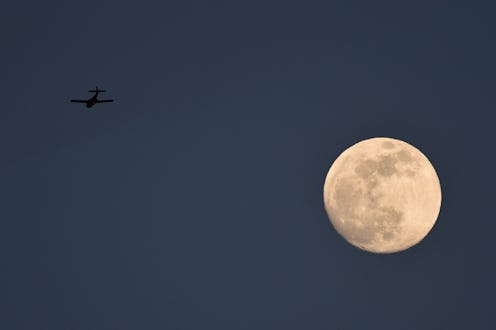Say hello to the longest day of the year, you guys. Today is the summer solstice, which signifies the beginning of the sunniest of seasons. But, bonus! This year features the first full moon to coincide with the summer solstice in 70 years. So what does a full moon on the summer solstice mean? Well, there are a few ways to look at this, and they all pretty much boil down to this special (and rare) phenomenon being kind of incredible.
Before we dive into some of the headier implications of this event, let's take a look at what is happening tonight. From the Latin solstitium — with sol meaning "sun" and stitium meaning "to stop" — solstices reflect days when the sun appears to stop in the sky. During the summer solstice, the sun is actually at its highest point of the year and the moon at its lowest, making it the day with the most sunlight hours. In 2016, the summer sun will reach this point in North American time zones at approximately 6:34 p.m. EDT, 5:34 p.m. CDT, 4:34 p.m. MDT, and 3:34 PDT.
Solstices are a time of celebration across many cultures. Called Litha in pagan and Wicca circles, the summer solstice is a time to reflect on one's inner brightness and power. It is also a time to rejoice in the beauty of the Earth's brightness during this sunny season. Perhaps the most well-known summer solstice celebration occurs at Stonehenge in Wiltshire, England. Some say the summer solstice also represents a battle between light and dark, for myriad reasons. This is time of the year when the sun overpowers darkness (hence the abundance of sun during the summer months), or when the mythical Oak King fights the Holly King for ruling rights, or when Demeter lets the world bloom while Persephone is home from the underworld.
A full moon falling on a summer solstice is mathematically supposed to occur every 15 years, but historically it's not been the case — the last summer solstice full moon was in 1948. "Having a full moon land smack on the solstice is a truly rare event," Slooh astronomer Bob Berman told TIME. "We probably won't push people off pyramids like the Mayans did, but Slooh will very much celebrate this extraordinary day of light with fascinating factoids and amazing live telescope feeds." (You can catch that live feed here.)
This summer solstice full moon is also an extremely particular type of full moon: a Strawberry Moon. But the Strawberry Moon did not receive its name due to its color; in fact, it doesn't generally appear red in color at all, but rather, more like honey or amber. The Strawberry Moon was given its name by Native American tribes because it occurs when strawberry-picking reaches its peak. Other names for it include the Rose Moon, the Honey Moon, and the Hot Moon, depending on what part of the world you are from.
Astrologically, the Strawberry Moon heralds a time of heightened insight and — hey-oh! — good luck. According to LunarCafe.com, you can convert the vibes put out by the June full moon into gains in fortune and prosperity. How? By clearing your mind of negative thoughts and thinking positively. It's kind of a cosmic "I'll meet you halfway" with the universe situation, if you will. Now is a good time to take stock of what you've got and be grateful. If you do, the universe will apparently heap her bounty upon you. So thanks for that, Strawberry Moon.
Images: Giphy (2)
